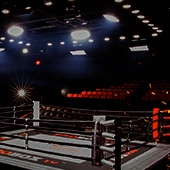By Thomas Gerbasi
Nearly six years after his tragic and still mysterious death, the reminders of Arturo Gatti are still there.
First there was a trip to Jersey City. It’s a melting pot that didn’t raise him – that honor went to Montreal – but it did adopt him, treating him as one of their own, a sports franchise with gloves, a mouthpiece, and the kind of heart Springsteen always sang about.
Then there was the Hall of Fame induction of Ray “Boom Boom” Mancini. Before Gatti thrilled fans on Saturday nights, Mancini did it on Saturday afternoons, and when it came time for voters to decide if these two action heroes deserved a plaque in Canastota, there was a debate about whether their body of work warranted it. Maybe not if you go strictly by wins and losses, but in terms of impact, both delivered above and beyond the call of duty. Both were inducted.
Finally, a quick look through some old boxes turned up my daughter’s autograph book, and wedged between an eclectic group of signatures that included Buzz Lightyear and Minnie Mouse alongside Wladimir Klitschko and Vernon Forrest was Arturo Gatti’s name. In January of 2004, Gatti held a press conference to promote his upcoming bout with Gianluca Branco. My daughter, eight years old at the time, wanted to see her favorite fighter, “Artoono” Gatti. Against all sense of professionalism, I brought her to the presser, and Main Events’ publicist at the time, Donald Tremblay, graciously let her in. Gatti, in the midst of personal issues, often stopped to shed a few tears in the midst of talking about his fight. But when my daughter approached him after the Q&A was done, he managed that unforgettable smile and a signature, making a little girl’s day.
Moments like that make fans, and I can’t fathom anyone not being a fan of what Arturo Gatti brought to the ring over the course of his 16-year career. At times it wasn’t pretty, yet at others you couldn’t picture anything more beautiful confined to the space between the ropes. If you ever shadowboxed in your room as a kid and pictured being in a championship fight, you likely weren’t picturing a Floyd Mayweather shutout; you wanted to be in a real-life version of a Rocky film, and that’s what Gatti delivered so many times.
There was precious little BS when it came to a Gatti fight. There was no false bravado, no intimidating stares or pre-fight antics. He stepped into the ring, attempted to box, and when he was able to, he could match technique for technique with practically anyone. But most times, all it took was a trip to the canvas, a bloody face or a swollen eye, or even just a hard crack to the face, and the Gatti everyone loved came out. And what may have added to his appeal once the brawling began is that he had no Joe Louis poker face. When he got hurt, you knew it, his opponent knew it, and everyone in the arena knew it too. For some that would be the kiss of death. For Gatti, it was a way of saying “yeah, I’m hurt, but I’m not hurt enough to stay down.”
Of course, for all his heart, for all his willingness to disregard his personal safety in search of victory, there were bad nights, nights when he found out that he wasn’t as good as a Floyd Mayweather or Oscar De La Hoya. But that’s part of the gig. In this sport, there’s always someone better sometime. Whether you fight that someone is something you have to deal with in your heart, yet when Gatti died under mysterious circumstances on July 11, 2009, two years after his retirement, that was a question he never had to ask himself.
He fought them all. He lost some, won most, but he never left the ring having to hang his head. His skin may have betrayed him, his hands may have abandoned him, but he always showed up to fight and when they called his name, he made the walk.
That’s why there’s an older generation of fans - the ones that always talk about the good ol’ days, when fighters fought the best and were focused more on being the best in the ring as opposed to being the best businessmen - who adopted Gatti. And there’s also the new generation, one that grew up on Gatti, and that looks at him, along with fighters like another man taken tragically young, Diego Corrales, as their patron saints, as the ideal of what it means to be a fighter. Not a boxer, but a fighter. That means perfection is not part of the package, but will is. And that will isn’t just to win, but to fight anyone put in front of them. There are fighters who still practice that ideal, but at the same time enough don’t to make it noticeable and make you want to go back to days when a Gatti fight meant you had to be home on Saturday night to watch it on HBO or make the trip to Atlantic City to see him live.
You can’t put a price on that, making it no wonder that even six years after his death, Arturo Gatti’s shadow still looms large over the fight game.
And in sixty years, the same will likely be true, making that a legacy any fighter would crave, one not ruled by championship belts or million dollar paydays, but by love and respect for a man who wore his heart on his sleeve and then displayed it to the world on fight night.
Just a reminder.
